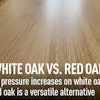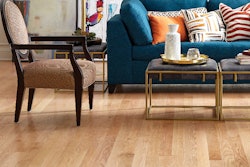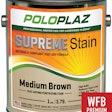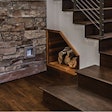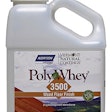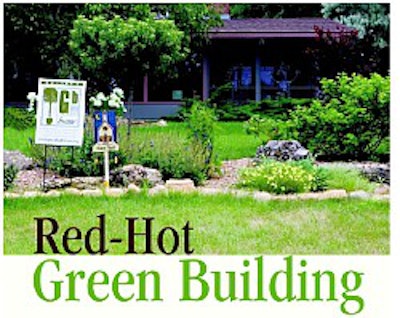
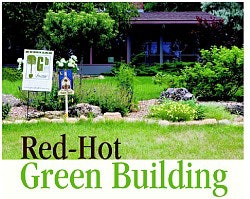
In today's construction market, "green" building is red-hot. Five years ago, the concept was outside the mainstream, with pockets of activity in stereotypically environmentally aware markets such as Portland, Ore., and Santa Fe, N.M. Today, more than 31 percent of builders report "more than moderate involvement" with green building, according to a study recently released by McGraw-Hill Construction and the National Association of Home Builders (NAHB), and the activity stretches across all parts of the country. "Consumers are now asking for green building products in their homes," says Ann Knight, executive vice president and marketing director at Bainbridge Island, Wash.-based manufacturer Teragren Bamboo Floors, Panels & Veneer. "I think it's paralleling the organic food industry." That industry has grown more than 32 percent in the U.S. over the last two years.
Depending on the certification used and the products involved, wood in general—and wood flooring products specifically—can be key elements in defining a building as green. Not all the green building programs agree on what types of wood flooring are "green," but regardless, the number of such programs is growing, along with their influence.
Defining "Green"
The best known and established of the construction certification programs is LEED (Leadership in Energy and Environmental Design), a national standard developed by the U.S. Green Building Council (USGBC) in 2000. Among other certifications, LEED offers LEED-New Construction (LEED-NC), which is designed to distinguish high-perfor mance commercial and institutional projects. The program has gained substantial traction in the industry—the estimated value of LEED-NC projects in 2005 was $7.73 billion. Building on the momentum of the commercial program, LEED is also in the pilot project stages of LEED for Homes, a similar residential program.
Meanwhile, the NAHB recognized the green building movement by introducing its own Model Green Home Building Guidelines in 2005. The voluntary guidelines were developed to help integrate environmental practices into homebuilding while prioritizing affordability, the association says. The National Wood Flooring Association was an involved "stakeholder" in the lengthy development process for establishing the NAHB guidelines. The not-for-profit Green Building Initiative (GBI) is licensed to promote the NAHB Model Green Home Building Guidelines to local homebuilder associations. Today, there are eight versions of the guidelines that can be easily adapted for different geographic regions of the U.S.
The GBI also has bought the rights to a commercial construction rating system for green building—Green Globes. Adapted from the program of the same name in Canada, Green Globes in the U.S. became an ANSI standards developer last September.
In addition to these programs recognizing the green value of entire construction projects, there are also comparably longestablished certifications recognizing green wood flooring. Certifications available for wood flooring include those from the Forest Stewardship Council (FSC), the Sustainable Forestry Initiative (SFI) and the Canadian Standards Association (CSA). (For more on these programs, see the article "Certifiable?" in the August/September 2003 issue of Hardwood Floors.)
Additionally, another certification—Greenguard—aims to recognize products that improve the quality of indoor air. Founded in 2001, Greenguard now has recognized 100,000 products from 60 manufacturers, including corporate giants such as Formica, DuPont and Benjamin Moore.
The Wood Connection
The upsurge of interest in green building has paid dividends for those in the wood flooring industry with obviously environmentally friendly products.
"For us, it's fabulous," says Carol Goodwin, CFO for Micanopy, Fla.-based reclaimed wood flooring manufacturer Goodwin Heart Pine. "We're up 35 percent for the year because of all these big green building projects." While those projects are in various locales around the country, there's particular interest coming from her own state, where the Florida Green Building Coalition (online at www.floridagreenbuilding.org) has developed green building codes for the entire state.
The trend has changed the way the company is marketing itself, Goodwin says. "We're pursuing green building a lot more than we ever have. The green building market is allowing us to tell our story and really make the most of it," she says, adding that the company is exhibiting at more home shows, most of them green building shows.
Likewise, business has also been booming for bamboo manufacturer Teragren. "Our revenues in 2005 were up 39 percent over 2004, and that's really because the demand for green building has grown a lot," Knight says. "It's because of the architects who want those LEED points, and also because the consumers are driving it." While Knight estimates that about 80 percent of the company's business is still residential, the company also enjoys the exposure of high-profile commercial projects, such as retail stores Timberland and Coldwater Creek. "All those retail stores want to go green; it's more politically correct," Knight says. "Now everybody's got a hybrid car. All the Hollywood celebrities are making it cool, and it's just the right thing to do."
At San Rafael, Calif.-based manufacturer EcoTimber, which handles a variety of environmentally oriented products, "We're seeing a lot more demand for recycled and certified wood flooring products, and cork and bamboo are exploding in popularity … anything with green attributes, especially those that qualify for LEED," says Dan Harrington, director of architectural sales and marketing.
Controversial Qualifications
Currently, wood flooring products that qualify for LEED are recognized under two areas: a credit for "rapidly renewable" materials, defined as those able to be regenerated in 10 years or less (essentially, cork and bamboo), and a credit for using FSC-certified wood flooring. Both qualifications have caused controversy. The "rapidly renewable" credit has earned LEED an anti-wood reputation: Wood proponents argue that their material is as renewable as bamboo, just not "rapidly" as defined by LEED. Additionally, wood proponents argue that the LEED guidelines should recognize SFI and CSA certifications as well as the FSC certification, which is generally seen as the most stringent and the one supported by most environmental groups.
To address those concerns, a proposal is being discussed within the USGBC to modify both points. The "rapidly renewable" credit would possibly be changed to a broader bio-based materials credit, including wood, and the certification credit would also possibly give recognition to SFI and CSA products while still awarding more points to FSC products. A key factor being discussed when considering the rapidly renewable credit is how to address the Life Cycle Assessment (LCA) of wood compared with other products. LCA analysis tracks the environmental impact of a product—including factors such as the effect on human health, resource depletion and ecosystem health—all the way from sourcing the product through its ultimate disposal, and in the research presented to the USGBC board, the LCA of wood was generally much more positive than the LCA of products created by rapidly renewable agricultural practices.
The current proposal has created a "firestorm" of controversy, says Harrington, who is on the USGBC's technical advisory committee for wood. "The USGBC proposal to recognize any certified wood is extremely controversial, because for the environmental community, that would essentially be rewarding some very destructive forestry practices," Harrington says. The main concern for environmentalists, he says, is the allowance of clearing old growth and converting old-growth forests into plantations under SFI and CSA certifications. Because of that concern, the proposal is likely to be voted down in coming months by USGBC membership, he predicts.
"The positive thing is they have acknowledged that the rapidly renewable notion is one that is not very sound," says Kelly McCloskey, president of the Chicago-based Wood Promotion Network, a coalition of more than 330 wood products manufacturers, associations and other groups, including the NWFA, which has been an active participant. "Something can be rapidly renewable but not very environmentally friendly, and vice versa. Someone using sustainably managed wood for hundreds of years is seen as less green by that standard than bamboo from China."
From the wood industry's perspective, all of the certifications are meaningful and beneficial compared with no certification at all. "We're certification-positive, certification-neutral," McCloskey says. "There are differences between them [the certifications], but the differences are minor compared with not having them."
That's why the Green Globes and NAHB guidelines recognize all the major certification systems, says Ward Hubbell, executive director of the GBI, adding that the Green Globes and NAHB guidelines also recognize renewability regardless of the time frame.
Hubbell says that the introduction of the Green Globes and NAHB guidelines are only beneficial for green interests. "We believe that in order for there to be traction for green building, there should be options out there, a lot of credible options," he says.
McCloskey agrees that competition among green building standards is positive, not only for environmental reasons, but also to avoid high prices on products that could be required under a more restrictive standard. Were the upcoming LEED for Homes standards to become widely adopted with the current structure, for example, "if somebody says you can't install flooring unless you meet the LEED standard, then you've got real price pressure up," he says.
The FSC Influence
Despite these issues, including concerns about the pricing of FSC-certified material, the FSC certification program continues to grow. The acreage of FSC-certified forests has doubled in the last two to three years, and the number of chain-of-custody-certified FSC suppliers has doubled in the last two years, Harrington says. Today, more than 75 percent of the wood that comes out of FSC-certified forests is sold on the common market without the FSC designation because there still aren't enough companies that are chain-of-custody-certified, he explains. "There's plenty of wood coming out of the forest; it's more of a problem of distribution and getting companies to be chain-of-custodycertified," he says.
In fact, oftentimes FSC wood flooring can be cost-neutral, he says, but because distribution is still lacking, the shipping can make it expensive. "If you are far away from our warehouse … the shipping makes it very expensive relative to the price you'd get on that same floor from your local distributor," he explains.
In spite of this challenge, demand for FSC-certified material is growing. One segment is coming from large projects with developers who have the capacity to plan ahead. For such projects, the wood flooring can be shipped directly from the mill to the job site, eliminating the extra shipping cost. "Certain developers are putting FSC wood into their big projects with regularity very successfully and without a lot of increase in cost, but it takes a lot of planning," Harrington says.
Another segment of the business comes from consumers asking for the product—Harrington estimates that 70 percent of the company's business is from retail showrooms where EcoTimber has displays with brochures explaining what FSC is. While consumers may not enter the showroom even knowing about the FSC, once the display introduces the concept and they learn more about the environmental aspects, they decide on FSC material, he says.
At Teragren, the company's bamboo products are recognized by all the certification types because of their rapidly renewable nature, but the company also has FSC certification on its Studio floating bamboo floor. For the company, the FSC certification is more philosophical than market-driven. "It helps us maintain our philosophy and goal to be socially and environmentally responsible. We're known for that, and architects specify us because they know we're the safe choice," Knight explains.
Consumer Demand
Consumers' increased interest in environmental products isn't affecting only wood flooring, but other wood flooring products and practices, as well. "As we researched the whole green market, it became obvious to us that we needed to do some very proactive marketing to attract the attention of the marketplace," says Gerry Mueller, director of marketing for Aurora, Colo.based BonaKemi USA, which manufactures flooring products from finish to dust containment systems. Mueller cites a study done by the Natural Marketing Institute concerning what marketers call Lifestyles Of Health and Sustainability (LOHAS) customers. The study divided consumers into four categories depending on how concerned they are about environmental issues when buying products and determined that 23 percent, or 50 million, are significantly affected by their concern for the health of their families and the sustainability of the environment when purchasing products. Taken with consumers from other categories who are sometimes concerned about environmental aspects, the numbers are significant. "The conclusion I came to is that the green demand is definitely mainstream, not the treehuggers and the Birkenstockers," Mueller says.
"Specifiers are always wary of people who claim to be 'green' without any third-party endorsement," Mueller says. To address that concern, Bona decided to seek Greenguard certification for its entire wood-finishing system, including its dust containment products, from sanding bare wood all the way to coating the floor. The process passed testing by an independent laboratory last December, and Bona now heavily promotes its Greenguard certification as part of its environmentally oriented corporate philosophy.
While Greenguard certification isn't currently part of LEED standards, it can be used for LEED's "innovation" credits, and Greenguard is referenced in the NAHB guidelines. Bona has developed an architectural specification with its Greenguard process. "A lot of architects, specifiers and building owners may not want to go through the extra effort to get LEED-certified, but they still want to build green buildings," Mueller explains, adding that there are already several cases where wood flooring contractors with Bona's dust containment system were chosen for large jobs specifically because they had the Greenguard-certified system.
Even for smaller jobs, having the system is a benefit, says Elaine Wetterstein, office manager at contractor Great Danish Craftsman Hardwood Flooring in Parker, Colo., because today's customers are more concerned about their own health, as well as the health of the environment. "Everyone's starting to get more environmentally conscious … people are thinking about it now more than ever," she says.
That awareness spans the country. Hubbell says that the NAHB green guidelines are being well-received everywhere, not just in typically environmental areas like the Pacific Northwest. "I could point to examples in just about every region … I think it was regional a few years ago, but it isn't now," he says.
The McGraw-Hill/NAHB study predicts that the trend will continue, with green building growing to a value between $19 billion and $38 billion by the year 2010. As the recognition of wood's positive environmental story continues to grow, that should be good news for environmentally friendly wood flooring products and the wood industry as a whole.
A GREEN GLOSSARY
Sorting through all the "green" certifications, guidelines and programs can be confusing. Here's a quick guide:
For Wood Flooring:
FSC: The Forest Stewardship Council (www.fsc.org) promotes responsible management of the world's forests. Products labeled as FSC are tracked with a rigorous chain-of-custody system from the forest to the end product. Independent certifiers—SCS: Scientific Certification Systems (www.scscertified.com/forestry) and Smartwood, which is a part of the Rainforest Alliance (www.rainforestalliance.org)—are used to determine FSC eligibility.
SFI: The Sustainable Forestry Initiative (www.aboutsfi.org) was developed by the American Forest & Paper Association (www.afandpa.org) and is overseen by the Sustainable Forestry Board (www.aboutsfb.org), an independent organization. Participation in the SFI program is a condition of membership in the AF & PA.
CSA: The Canadian Standards Association (www.csa.ca) has the National Standard for Sustainable Forest Management, a chain-ofcustody program designed to chart the progress of forest products from the forest through all stages of production to the consumer.
For Any Product:
Greenguard: The Greenguard Environmental Institute (www.greenguard.org) is an industry-independent, nonprofit organization with a mission to improve public health and the quality of life through programs that improve indoor-air quality. Among others, Greenguard offers a certification program for low-emitting interior products and materials.
For Construction:
LEED (Leadership in Energy and Environmental Design): This voluntary standard is best known for its certification of new construction of commercial and institutional buildings. It was developed by members of the U.S. Green Building Council (www.usgbc.org). Buildings can earn up to 69 points resulting in four possible levels of recognition. A LEED for Homes rating system is currently in the pilot testing phase.
Green Globes: This voluntary standard program for commercial buildings has been more widespread in Canada. In 2004, the Green Building Initiative (www.thegbi.org), a nonprofit network of building industry leaders, acquired the rights to distribute Green Globes in the United States. Green projects can earn up to four globes.(www.greenglobes.com)
NAHB Model Green Building Guidelines: These guidelines for residential buildings from the National Association of Home Builders were designed to help local homebuilder associations create their own green building programs. To download a PDF version of the guidelines, visit www.nahb.com/gbg. The GBI has the license to market and promote the NAHB Green Building Guidelines.













